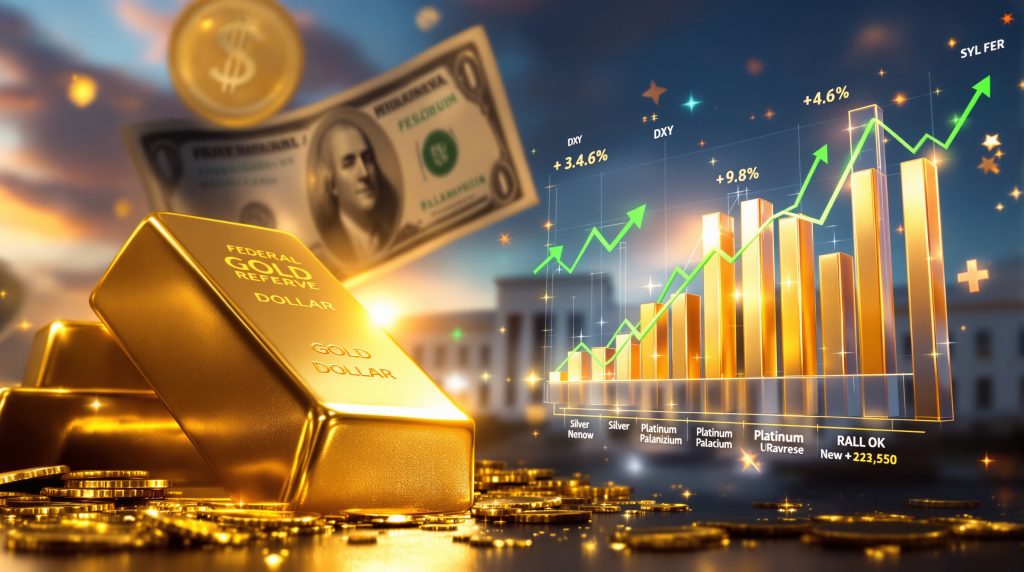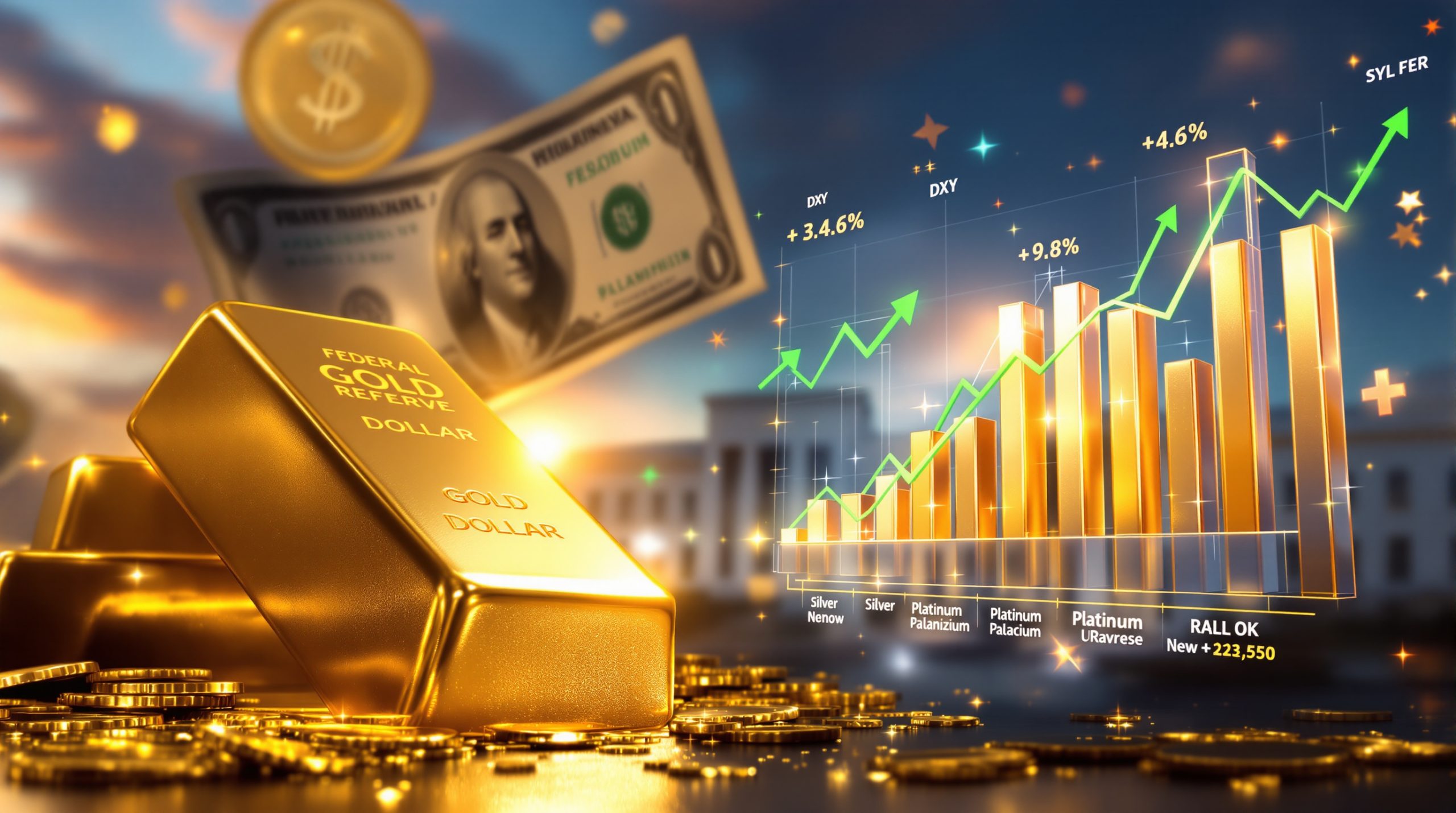Gold rises on softer dollar conditions continue creating compelling opportunities for precious metal investors during November 2025. The relationship between currency strength and precious metal valuations represents one of the most reliable patterns in financial markets. During November 2025, this dynamic played out dramatically as gold achieved significant weekly gains while the dollar index experienced consecutive weeks of decline. Furthermore, recent gold all-time highs demonstrate the ongoing strength of this precious metal. Understanding these mechanics provides essential insights for investors navigating current market conditions.
Understanding the Currency-Gold Price Connection
Gold's international pricing in U.S. dollars creates immediate effects when currency values shift. As the dollar weakens, foreign investors holding non-USD currencies require fewer units of their home currency to purchase the same amount of gold, effectively increasing international buying power and demand pressure.
Market Performance Data (November 14, 2025):
- Spot gold: $4,183.31 per ounce (+0.3% daily)
- Weekly gold performance: +4.6%
- Dollar index: Second consecutive weekly decline
- International demand surge from currency holders outside the USD
This purchasing power equation operates continuously across global markets. When European investors see dollar weakness, their euro-denominated buying power for gold increases proportionally. Similarly, investors holding Japanese yen, British pounds, or other major currencies experience enhanced purchasing capacity during dollar decline periods.
The opportunity cost framework provides additional support for gold during currency weakness periods. Weaker dollars typically correspond with lower U.S. Treasury yields, reducing the competition between non-yielding gold and cash-equivalent instruments. Investors face less penalty for holding precious metals when alternative USD-denominated investments offer diminished returns.
Cross-currency demand patterns amplify these effects through systematic positioning. Central banks and institutional investors actively manage currency exposure alongside commodity holdings, creating predictable demand pressures during sustained dollar weakness. This institutional behaviour adds momentum to currency-driven gold movements.
Federal Reserve Policy Impact on Precious Metal Markets
Federal Reserve monetary policy decisions create immediate ripple effects through precious metal markets. Current market conditions demonstrate this sensitivity, with traders closely monitoring rate cut probabilities and policy communication for investment positioning signals. Moreover, the gold price forecast indicates continued upward momentum amid these evolving conditions.
December 2025 Rate Cut Expectations:
| Probability Shift | Market Impact |
|---|---|
| Previous session: 64% | Strong bullish sentiment |
| Current probability: 51% | Moderate upward pressure |
| 13-point decline | Reduced dovish expectations |
The sharp probability adjustment reflects market sensitivity to Federal Reserve communication and economic data interpretation. Chair Jerome Powell's cautious stance regarding additional rate reductions, citing insufficient data availability, contributed to this expectation shift. Market participants interpreted recent Fed policymaker statements as signalling reluctance toward aggressive easing policies.
Interest rate expectations transmit to gold prices through multiple channels. Real yield calculations compare nominal interest rates against inflation expectations, determining the opportunity cost of holding non-yielding precious metals. Lower anticipated rates reduce this opportunity cost, supporting gold valuations.
The inflation expectations channel operates independently but reinforces rate policy effects. Fed communications regarding inflation management directly influence long-term price level expectations, affecting gold's appeal as an inflation hedge. During periods of policy uncertainty, investors shift toward safe-haven positioning, creating additional demand independent of pure yield considerations.
Policy Transmission Mechanisms:
- Real yield adjustments: Lower expected rates reduce gold opportunity costs
- Inflation hedge positioning: Policy uncertainty increases safe-haven demand
- Dollar strength correlation: Hawkish expectations typically strengthen USD, pressuring gold
- Risk-off flows: Policy confusion drives defensive asset allocation
Recent market behaviour illustrates these dynamics. Despite the decline in December rate cut probability from 64% to 51%, gold maintained weekly strength at +4.6% gains, suggesting broader dollar weakness and international demand factors outweighed hawkish policy signals.
Economic Indicators Driving Gold Market Direction
Economic data releases create immediate volatility in precious metal markets, with specific indicators carrying disproportionate influence over investor sentiment and positioning decisions. The recent 43-day government shutdown demonstrated how information gaps amplify market uncertainty and support gold prices.
Data Disruption Impact Analysis:
- Shutdown duration: Record 43 days ending approximately November 14, 2025
- Information gap effects: Employment reports, inflation data, manufacturing indicators suspended
- Market response: Increased policy uncertainty supporting precious metal demand
- Investor behaviour: Risk-off positioning during data blackout periods
According to Reuters, gold rises on softer dollar conditions create favourable conditions for precious metal accumulation. This pattern demonstrates the consistent inverse relationship between currency strength and gold valuations.
Labour market indicators typically drive Federal Reserve policy expectations, indirectly influencing gold through rate anticipation adjustments. Non-farm payroll reports, unemployment rates, and average hourly earnings provide Fed policymakers with employment condition assessments. Stronger labour market data supports hawkish positioning and higher rate expectations, creating headwinds for non-yielding gold.
Inflation measures including Consumer Price Index, Producer Price Index, and Personal Consumption Expenditures directly affect gold's inflation hedge appeal. Higher inflation expectations increase precious metal attractiveness whilst simultaneously influencing Fed rate decisions. This dual effect can create complex market dynamics during transitional economic periods.
Critical Economic Indicators:
- Labour market strength: Non-farm payrolls, unemployment rate, wage growth
- Inflation pressure: CPI, PPI, PCE measurements
- Currency strength: Dollar index technical levels and trend direction
- Growth indicators: GDP, industrial production, manufacturing PMI
Forward-looking indicators including consumer sentiment surveys and Conference Board Leading Economic Index sometimes provide advance signals for official data trends. These expectations-based measurements can influence market positioning before official government statistics release.
Precious Metal Performance Comparison During Dollar Weakness
Different precious metals exhibit varying sensitivity to dollar weakness based on their industrial demand components and market dynamics. November 2025 performance data reveals significant divergence between metals despite shared exposure to currency effects. Additionally, understanding the gold investment outlook helps investors position appropriately across different metals.
Weekly Performance Analysis (November 10-14, 2025):
| Metal | Weekly Gain | Current Price | Primary Demand Drivers |
|---|---|---|---|
| Silver | +9.3% | $52.82/oz | Monetary + Industrial |
| Gold | +4.6% | $4,183.31/oz | Monetary + Safe haven |
| Platinum | +0.4% | $1,586.80/oz | Industrial + Automotive |
| Palladium | +0.2% | $1,429.80/oz | Automotive + Supply constraints |
Silver's exceptional 9.3% weekly performance, significantly outpacing gold's 4.6% gain, reflects dual exposure to monetary policy factors and industrial demand considerations. The metal serves essential roles in electronics manufacturing, solar panel production, medical applications, and other industrial processes. This industrial component amplifies silver's response to economic growth expectations and monetary policy changes.
The lower absolute price point for silver ($52.82/oz versus gold's $4,183.31/oz) creates higher percentage volatility for equivalent absolute price movements. Silver typically demonstrates higher beta relative to gold during both risk-on and risk-off market environments, explaining the performance differential during currency weakness periods.
Platinum's limited 0.4% response indicates weaker sensitivity to monetary factors compared to gold and silver. Approximately 40% of platinum demand originates from automotive catalytic converter applications, with jewellery comprising additional demand. The automotive sector's current recovery status directly influences platinum pricing independent of dollar effects.
Palladium's minimal 0.2% weekly gain reflects heavy dependence on automotive sector demand, with approximately 80% of consumption linked to catalytic converter production. Supply constraints from Russian and South African mining operations may support prices independent of currency effects, but industrial demand cycles override monetary policy considerations.
Industrial Versus Monetary Sensitivity:
- High monetary sensitivity: Gold, silver
- Mixed sensitivity: Silver (dual exposure)
- Industrial dominance: Platinum, palladium
- Supply constraint effects: Palladium specifically
Market liquidity differences also influence relative performance. Gold and silver maintain larger, more liquid markets with extensive futures and options trading infrastructure. Platinum and palladium operate in smaller markets with different price discovery mechanisms and institutional participation patterns.
Strategic Investment Positioning for Currency-Driven Moves
Successful precious metal investing during currency volatility requires systematic approach to timing, allocation, and risk management. Current market conditions present specific opportunities for informed investors understanding dollar-gold dynamics. Furthermore, gold driving highs analysis provides valuable insights for strategic positioning.
Technical Analysis Framework:
Dollar index technical levels provide primary signals for gold positioning decisions. Historical analysis indicates DXY moves below 100 often trigger accelerated precious metal buying, while levels above 105 create systematic headwinds. Current dollar weakness toward second consecutive weekly decline suggests favourable technical environment.
Federal Reserve meeting preparation involves positioning ahead of policy announcements and economic data releases. The December rate cut probability currently at 51% creates uncertainty that typically supports gold prices regardless of ultimate policy decisions. This uncertainty premium rewards defensive positioning.
Portfolio Allocation Guidelines:
| Risk Profile | Precious Metals Allocation | Strategy Focus |
|---|---|---|
| Conservative | 5-10% | Core gold holdings |
| Moderate | 10-15% | Diversified metals |
| Aggressive | 15-20% | High-conviction opportunities |
Economic calendar awareness enables tactical positioning around key data releases. First Friday employment reports, monthly CPI releases, and Fed meeting dates create predictable volatility windows. The recent 43-day data disruption demonstrates how information gaps can extend uncertainty periods and support precious metal demand.
Risk management requires understanding correlation patterns during different market environments. While gold and silver typically move together during currency weakness, their industrial demand components can create divergence during economic growth transitions. Platinum and palladium exhibit different correlation patterns based on automotive sector conditions.
Timing Considerations:
- Dollar trend identification: Monitor DXY support and resistance levels
- Fed communication analysis: Track policy maker statements and meeting minutes
- Data release positioning: Prepare for volatility around key economic indicators
- Correlation monitoring: Assess precious metal relationships during market stress
Position sizing should reflect individual risk tolerance and broader portfolio construction principles. Precious metals serve portfolio diversification benefits beyond pure return generation, providing non-correlated asset performance during market stress periods.
Long-Term Implications of Dollar-Gold Market Dynamics
Structural trends in global monetary policy create sustained opportunities for precious metal investors who understand cross-currency relationships and central bank behaviour patterns. Current economic conditions suggest these dynamics may persist beyond immediate policy cycles. In addition, investing amid uncertainty requires understanding these long-term structural shifts.
Global monetary policy divergence between major central banks creates ongoing currency volatility that supports precious metal demand. As different economies experience varying inflation pressures, growth rates, and policy responses, relative currency values fluctuate continuously. These fluctuations maintain consistent opportunities for currency-aware precious metal positioning.
What Are the Inflation Hedge Characteristics?
Precious metals provide protection against currency debasement through both direct price appreciation and purchasing power maintenance. Historical analysis demonstrates gold's effectiveness during sustained inflationary periods, when traditional fixed-income investments struggle to maintain real returns.
Real return protection becomes increasingly important during periods of financial repression, when official interest rates remain below inflation rates. Central bank policies designed to reduce government debt burdens through negative real rates create systematic incentives for hard asset allocation including precious metals.
Portfolio diversification benefits extend beyond simple return correlation analysis. Precious metals exhibit different behavioural patterns during various economic stress scenarios including currency crises, geopolitical tensions, and financial system instability. This behavioural diversity provides insurance-like characteristics for comprehensive portfolio risk management.
Structural Support Factors:
- Central bank accumulation: Continued official sector gold purchases
- Currency diversification: International movement away from pure USD reserves
- Inflation expectations: Long-term price level uncertainty
- Geopolitical insurance: Safe-haven demand during international tensions
Mining supply constraints may provide additional long-term price support independent of currency dynamics. Major gold producing regions face increasingly challenging geological conditions, higher extraction costs, and extended development timelines for new projects. These supply-side limitations support price floors during demand expansion periods.
Market Psychology and Investment Decision Making
Understanding investor psychology during currency-driven precious metal movements enhances positioning effectiveness and risk management outcomes. Current market behaviour demonstrates typical patterns that informed investors can recognise and utilise.
Fear-driven demand creates momentum effects during currency weakness periods. As dollar decline accelerates, investors increasingly focus on currency debasement risks and seek protective assets. This psychological shift can create self-reinforcing price trends that extend beyond fundamental valuation metrics.
Information uncertainty amplifies these psychological effects. The recent 43-day government shutdown created data gaps that forced investors to make decisions with incomplete information. During such periods, conservative positioning toward perceived safe assets typically increases regardless of specific fundamental conditions.
Investor Behaviour Patterns:
- Uncertainty premium: Additional demand during information gaps
- Momentum effects: Self-reinforcing trends during currency moves
- Risk-off positioning: Defensive allocation during policy uncertainty
- Inflation psychology: Preemptive hedging against currency debasement
Professional versus retail investor behaviour often creates distinct market phases. Institutional investors typically position based on systematic analysis and risk management protocols, whilst retail participation may increase during late-stage trend acceleration. Understanding these participation patterns helps identify trend maturity and potential reversal points.
Key Success Factors for Gold Investment During Dollar Weakness
Effective precious metal investing during currency volatility requires systematic approach combining technical analysis, fundamental understanding, and disciplined risk management. Current market conditions provide multiple entry points for various investment objectives. Moreover, as reported by Trading Economics, gold rises on softer dollar trends continue supporting precious metal valuations.
Essential Monitoring Systems:
- Dollar index technical analysis: Track DXY trend direction and key levels
- Federal Reserve communication: Monitor policy maker statements and meeting outcomes
- Economic data flow: Assess inflation, employment, and growth indicators
- International demand patterns: Observe central bank and institutional activity
Portfolio allocation should reflect both short-term tactical opportunities and long-term strategic positioning. The dollar-gold relationship provides consistent patterns that reward patient, systematic investors whilst creating shorter-term trading opportunities for more active approaches.
Risk management protocols must account for precious metals' unique characteristics including storage costs, liquidity variations, and tax implications. Physical metals, exchange-traded funds, mining stocks, and derivative instruments each offer different risk-return profiles suitable for various investment objectives.
Implementation Strategies:
- Systematic positioning: Regular allocation adjustments based on technical and fundamental signals
- Volatility management: Position sizing appropriate for precious metals' price characteristics
- Correlation awareness: Understanding relationships between different metals and broader markets
- Cost efficiency: Selecting investment vehicles appropriate for holding periods and portfolio size
The relationship between currency strength and precious metal performance remains one of the most reliable patterns in financial markets. Current conditions featuring Federal Reserve policy uncertainty, government operational disruptions, and shifting rate expectations create compelling opportunities for informed investors who understand these dynamics.
Success requires combining technical analysis of currency trends, fundamental assessment of monetary policy direction, and disciplined portfolio management practices. The November 2025 market environment demonstrates these principles in action, with gold achieving significant gains during dollar weakness despite reduced rate cut expectations.
This analysis is for educational purposes only and does not constitute investment advice. Precious metal investments carry risks including price volatility, storage costs, and potential for capital loss. Market conditions and Federal Reserve policies may change, affecting future price performance. Investors should conduct their own research and consult qualified financial advisors before making investment decisions.
Want to Capitalise on the Next Major Mineral Discovery?
Discovery Alert instantly identifies significant ASX mineral discoveries using its proprietary Discovery IQ model, transforming complex geological announcements into actionable investment opportunities for both traders and long-term investors. Explore how historic mineral discoveries have generated exceptional returns and begin your 30-day free trial today to position yourself ahead of the market.




